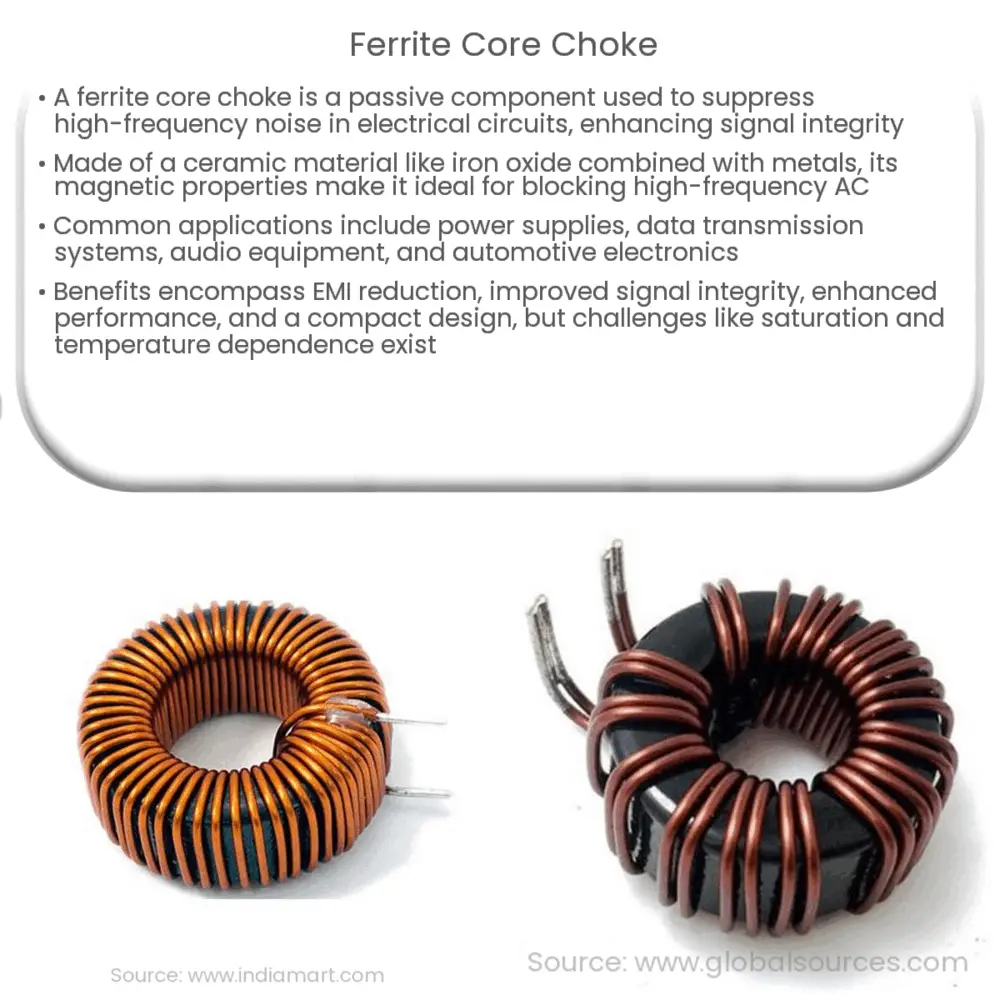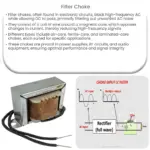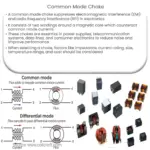A ferrite core choke is a passive component that suppresses high-frequency noise in circuits, improving signal integrity and reducing electromagnetic interference.

Ferrite Core Choke: A Comprehensive Overview
A ferrite core choke is a passive electronic component used to suppress high-frequency noise in electrical circuits. This component helps to minimize electromagnetic interference (EMI) and radio frequency interference (RFI), ensuring optimal performance and signal integrity. In this article, we’ll explore the workings of ferrite core chokes, their applications, and the benefits they provide.
Understanding Ferrite Core Chokes
Ferrite is a type of ceramic material composed of iron oxide mixed with other metals like nickel, zinc, and manganese. Ferrite materials exhibit unique magnetic properties, such as high permeability and low coercivity, making them suitable for use in inductive components like chokes, transformers, and inductors.
A choke is an inductor designed to block or “choke” high-frequency alternating current (AC) while allowing low-frequency direct current (DC) to pass through. Chokes are commonly used in power supplies and electronic circuits to filter out unwanted high-frequency noise. A ferrite core choke consists of a coil of wire wound around a ferrite core. The wire winding and ferrite core together form an inductor with specific magnetic properties that allow it to effectively suppress high-frequency noise.
Applications of Ferrite Core Chokes
Ferrite core chokes are utilized in a wide range of electronic applications, such as:
- Power Supplies: Chokes are often employed in switching power supplies to reduce EMI generated during the rapid switching of voltage regulators. They are also used in linear power supplies to filter out residual AC noise from the rectified DC output.
- Data Transmission: In data transmission systems, ferrite core chokes can suppress high-frequency noise that can interfere with signal integrity, improving data transmission quality and reducing bit error rates.
- Audio Equipment: Ferrite core chokes can be found in audio equipment like amplifiers, where they help to reduce high-frequency noise and minimize audio distortion.
- Automotive Electronics: In modern vehicles, ferrite core chokes are used to filter out high-frequency noise generated by various electronic systems, ensuring reliable operation and reducing the risk of interference with other vehicle systems.
Benefits of Ferrite Core Chokes
Incorporating ferrite core chokes in electronic circuits offers several advantages, including:
- EMI Reduction: Chokes effectively suppress EMI, ensuring that electronic devices meet regulatory standards and do not interfere with the operation of other devices.
- Improved Signal Integrity: By filtering out high-frequency noise, ferrite core chokes help maintain signal integrity and reduce the risk of data corruption and transmission errors.
- Enhanced Performance: Minimizing noise in electronic circuits can result in improved overall performance, lower error rates, and increased reliability.
- Compact Design: Ferrite core chokes are typically smaller and lighter than other types of chokes, making them an attractive option for space-constrained applications.
Selecting the Right Ferrite Core Choke
Choosing the appropriate ferrite core choke for a specific application requires consideration of several factors, including:
- Frequency Range: The ferrite material’s permeability varies with frequency. Select a choke with a ferrite core that offers high permeability within the frequency range of the noise to be suppressed.
- Impedance: The choke’s impedance should be high enough to provide effective noise suppression without negatively impacting the desired signal. Impedance is a function of the core material, wire winding, and geometry of the choke.
- Current Rating: The choke should be capable of handling the required current without saturating or overheating. Exceeding the choke’s current rating may lead to a decrease in performance and potential failure.
- Physical Size and Mounting Style: Consider the available space and mounting requirements for the choke in your design. Ferrite core chokes are available in various sizes and mounting styles, including surface-mount, through-hole, and clip-on designs.
Challenges and Limitations
While ferrite core chokes offer numerous benefits, they also present some challenges and limitations, such as:
- Saturation: Ferrite core chokes can saturate at high current levels, resulting in a reduction of inductance and a decrease in noise suppression performance. It is essential to select a choke with an appropriate current rating to avoid saturation.
- Temperature Dependence: The magnetic properties of ferrite materials can be affected by temperature changes. As temperature increases, the permeability of the core may decrease, reducing the choke’s effectiveness. Ensure that the choke’s operating temperature range is compatible with your application’s requirements.
- Core Losses: Ferrite core chokes can exhibit core losses due to the conversion of magnetic energy into heat, leading to decreased efficiency and potential thermal issues. Selecting a choke with a low core loss rating can help mitigate this issue.
Conclusion
Ferrite core chokes play a crucial role in suppressing high-frequency noise and maintaining signal integrity in a wide array of electronic applications. By understanding the underlying principles, applications, benefits, and challenges associated with ferrite core chokes, designers can effectively incorporate them into their circuits to enhance overall performance, reduce EMI, and ensure compliance with regulatory standards. Remember to consider factors like frequency range, impedance, current rating, and physical size when selecting the appropriate ferrite core choke for your specific application.




